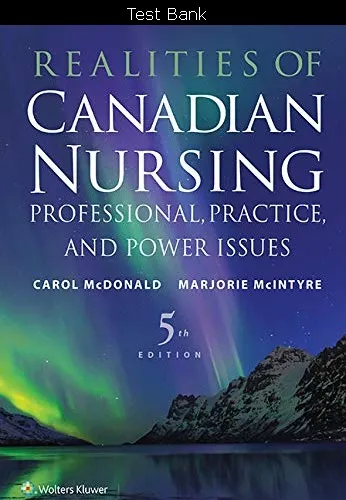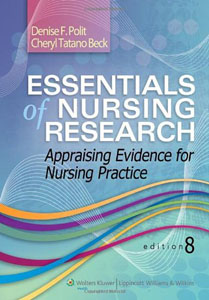Realities of Canadian Nursing Professional Practice and Power Issues 5th Edition McDonald Mclntyre Test Bank
$55.00 Original price was: $55.00.$23.00Current price is: $23.00.
Digital item No Waiting Time Instant Download
Chapters: 26
Format: PDF
ISBN-13: 978-1496384041
ISBN-10: 1496384040
Publisher: LWW
Authors: Carol McDonald, Marjorie McIntyre
Description
Realities of Canadian Nursing Professional Practice and Power Issues 5th Edition McDonald Mclntyre Test Bank
Table of Contents
Chapter 15 Issues in Contemporary Nursing Leadership
Realities of Canadian Nursing Professional Practice and Power Issues 5th Edition McDonald Mclntyre Test Bank
Chapter 1 Nursing Issues: A Call to Political Action
1. When describing the NCLEX examination, which of the following would the
instructor include?
A) Includes content standardized for baccalaureate education in nursing
B) Measures minimum technical competencies for safe entry into basic
nursing practice
C) Tests content determined appropriate for practice entry by the American
Nurses Association
D) Requires different passing scores for RNs educated at the ADN level
than at the BSN level
Ans: B
2. Which of the following would a prospective student expect to find when
examining a typical associate degree in nursing (ADN) program?
A) A maximum requirement for 120 semester hours or 180 quarter units
B) Similar curricular content as BSN programs, with greater clinical hours
C) Completion possible within 18 months to 2 years
D) Additional coursework for preparation to practice in multiple settings
Ans: D
3. Raising the educational level for entry into professional nursing
A) Should be relatively easy due to unanimous support
B) Is likely to have a short-term effect of reducing the current nursing
shortage
C) May increase recruitment to and retention in the field in the long run
D) May destabilize the nursing workforce due to increased job satisfaction
for ADNs
Ans: C
4. Which of the following best reflects most of the RNs working in Canada
today?
A) They have received an associate degree in nursing (ADN).
B) They have adequate educational preparation for roles in leadership and
management.
C) There are significant differences in care provided by ADN- and BSN-
prepared nurses.
D) Separate NCLEX examinations are supported for BSN- and ADN-
educated nurses.
Ans: A
4. Which of the following best reflects most of the RNs working in the Canada
today?
A) They have received an associate degree in nursing (ADN).
B) They have adequate educational preparation for roles in leadership and
management.
C) There are significant differences in care provided by ADN- and BSN-
prepared nurses.
D) Separate NCLEX examinations are supported for BSN- and ADN-
educated nurses.
Ans: A
5. A nursing instructor is teaching a group of students about grandfathering that
may result if the entry level to nursing practice is raised. The instructor
determines that the teaching was successful when the students describe it as
which of the following?
A) A way to allow an individual to continue to practice his or her profession
or occupation after new qualifications has been enacted into law
B) A mandate for nurses with greater education and knowledge levels to be
responsible for supervising those prepared at lower levels
C) A necessary requirement by state and federal laws when educational
entry requirements change
D) A concept that is not supported by most professional nursing associations
that support raising the entry level for professional nursing practice
Ans: A
6. Transitioning from a predominantly ADN educational model of nursing
education to a baccalaureate model
A) Is already occurring in a seamless, integrated manner that maximizes the
use of educational resources
B) Will be relatively inexpensive, given that adequate institutions of higher
learning already exist to meet this need
C) Will require the development of alternative pathways for RN education
for learners who may not otherwise be able to pursue additional nursing
education
D) Is primarily limited to nursing education in Canada
Ans: C
7. Which of the following would a nurse identify as a positive force for raising
the educational entry level in professional nursing?
A) There is often little if any difference in pay between BSN- and ADN-
educated nurses.
B) Patient outcomes are better when ADN representation in the staffing mix
is high.
C) Consumers generally have no understanding of the entry-to-practice
issue in nursing.
D) The entry level in nursing is significantly lower than for other health
professions.
Ans: D
8. A group of students is reviewing for a test on levels of preparation for
nurses. Which of the following if stated by the students as reflecting Mildred
Montags view of associate degree educational programs indicates that the
students have understood the information?
A) Preparation for beginning, technical practitioners who would provide
direct, safe nursing care under the supervision of the professional nurse
in an acute-care setting
B) Preparation of advanced professional nurses capable of the independent
judgment and autonomy required to successfully function as RNs in the
21st century
C) Preparation of professional registered nurses who could function safely
in a variety of health care settings including acute care, home care, and
public health
D) Preparation of broadly educated registered nurses with an understanding
of cultural, political, economic, and social issues affecting patients and
health care delivery
Ans: A
9. Which of the following best reflects the suggestions of the 1965 position
paper by the American Nurses Association for nursing education?
A) The education of all those who are licensed to practice nursing should
take place ininstitutions of higher education.
B) Minimum preparation for beginning professional nursing practice should
be the associate degree in nursing.
C) Minimum preparation for beginning technical practice should be the
baccalaureate degree in nursing.
D) There was no need for assistant nurses in the health care occupations.
Ans: A





Be the first to review “Realities of Canadian Nursing Professional Practice and Power Issues 5th Edition McDonald Mclntyre Test Bank”